Apple has made a pretty big splash with this year’s release of the 10th-generation iPad (2022), leaving its classic tablet design behind and bringing the entry-level iPad into harmony with the modern aesthetic of its higher-end models.
- iPad versus iPad Air specs
- iPad versus iPad Air design and display
- iPad versus iPad Air performance
- iPad versus iPad Air battery life and charging
- iPad versus iPad Air cameras
- iPad versus iPad Air software and updates
- iPad versus iPad Air special features
- iPad versus iPad Air price and availability
- Overall winner: iPad Air (2022)
This change is more than skin-deep. The iPad (2022) doesn’t just get the new design language of its more premium siblings; it also receives some boosts to its specs to bring it closer to the iPad Air (2022) — plus a slightly increased price tag to match.

With the iPad and iPad Air closer in design, specs, and performance than ever before, it’s a tougher call this year as to which one is worth spending your money on. Read on as we compare the two iPads head to head.
iPad versus iPad Air specs
| Apple iPad (2022) | Apple iPad Air (2022) | |
|---|---|---|
| Size | 248.6 by 179.5 by 0.28mm (9.79 by 7.07 by 0.28 inches) |
247.6 by 178.5 by 6.1mm (9.74 by 7.02 by 0.24 inches) |
| Weight | Wi-Fi: 477 grams (1.05 pounds) Wi-Fi + Cellular: 481 grams (1.06 pounds) |
Wi-Fi: 461 grams (1.02 pounds) Wi-Fi + Cellular: 462 grams (1.02 pounds) |
| Screen | 10.9-inch Liquid Retina display with True Tone | 10.9-inch laminated Liquid Retina display with True Tone and antireflective coating |
| Screen resolution | 2360 x 1640 at 264 pixels per inch | 2360 x 1640 at 264 ppi |
| Operating system | iPadOS 16 | iPadOS 16 |
| Storage | 64GB, 256GB | 64GB, 256GB |
| MicroSD card slot | No | No |
| Processor | Apple A14 Bionic | Apple M1 |
| Camera | Rear: 12-megapixel wide Front: 12MP landscape ultrawide |
Rear: 12MP wide Front: 12MP ultrawide |
| Video | 4K at up to 60 frames per second | 4K at up to 60 fps |
| Bluetooth version | Bluetooth 5.2 | Bluetooth 5.0 |
| Ports | USB-C | USB-C |
| Fingerprint sensor | Touch ID | Touch ID |
| Water resistance | None | None |
| Battery | Up to 10 hours on Wi-Fi, nine hours on cellular | Up to 10 hours on Wi-Fi, nine hours on cellular |
| App marketplace | Apple App Store | Apple App Store |
| Network support | Wi-Fi 6 (802.11ax) 5G (Sub-6, cellular models only) |
Wi-Fi 6 (802.11ax) 5G (Sub-6, cellular models only) |
| Accessory compatibility |
Apple Pencil (1st-gen) Magic Keyboard Folio |
Apple Pencil (2nd-gen) Magic Keyboard, Smart Keyboard Folio |
| Colors | Blue, pink, silver, yellow | Space Gray, blue, pink, purple, Starlight |
| Price | Wi-Fi: $449 Wi-Fi + Cellular: $599 |
Wi-Fi: $599 Wi-Fi + Cellular: $749 |
| Buy from | Apple | Apple |
| Review | iPad (2022) review | iPad Air (2022) review |
iPad versus iPad Air design and display
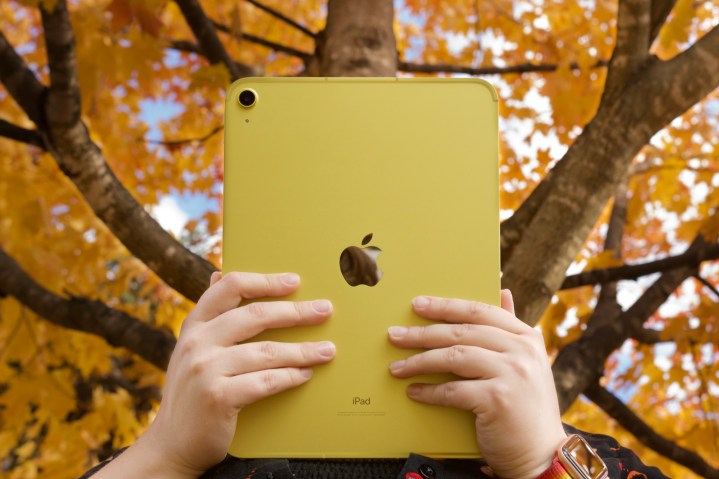
At a glance, the iPad (2022) and iPad Air (2022) are virtually indistinguishable. It’s been four years since Apple introduced this new flat-edged design with the 2018 iPad Pro, but it’s finally been adopted across the entire iPad lineup.
Technically, the iPad (2022) is slightly larger and heavier than the iPad Air (2022), but only about 0.05 inches in each direction. It’s enough to prevent many cases from being used interchangeably but not enough to notice unless you’re laying the two tablets on top of each other.
Even so, there are some noticeable visual differences. The iPad (2022) moves the front camera to the long edge — a first for Apple’s tablets — and lacks the magnetic connector for the second-generation Apple Pencil. The Smart Connector also remains on the left edge, opposite the camera; that’s similar to where it was located on its predecessors, but it’s an unusual distinction from the iPad Air and iPad Pro, both of which have the Smart Connector on the back.
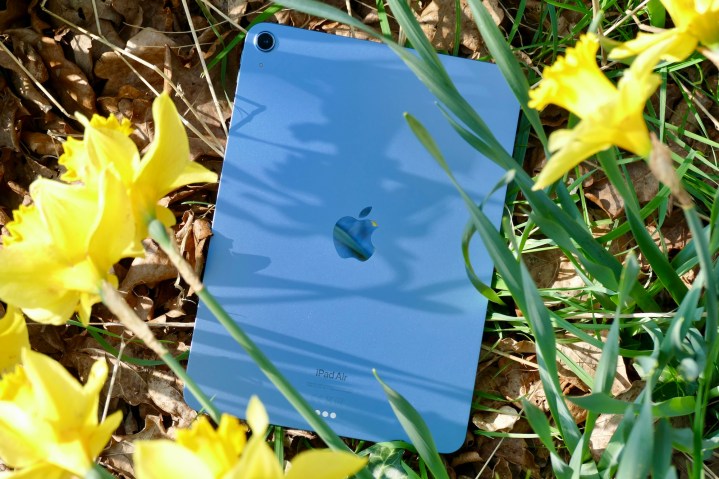
This is where the new design belies some of the differences between the iPad (2022) and the iPad Air (2022). The two tablets may look nearly identical, but they don’t support the same accessories. Since it uses the rear Smart Connector, Apple’s Magic Keyboard only works with the more expensive iPad Air and iPad Pro; iPad (2022) buyers will need to opt for Apple’s new Magic Keyboard Folio instead. Likewise, the lack of a magnetic charger for the second-generation Apple Pencil means you’ll only be able to use the first-generation Apple Pencil.
Thankfully, the displays on the iPad (2022) and iPad Air (2022) are much closer in specs. In fact, they’re identical in size (10.9 inches), resolution (2360 x 1640 at 264 pixels per inch), and brightness (500 nits). They also both support Apple’s True Tone display technology. However, the iPad Air gets an edge with its fully laminated display with an anti-reflective coating and also supports the P3 wide color gamut. This means the iPad Air display can offer richer and more realistic colors, and you’ll have an easier time seeing it in brighter lighting.
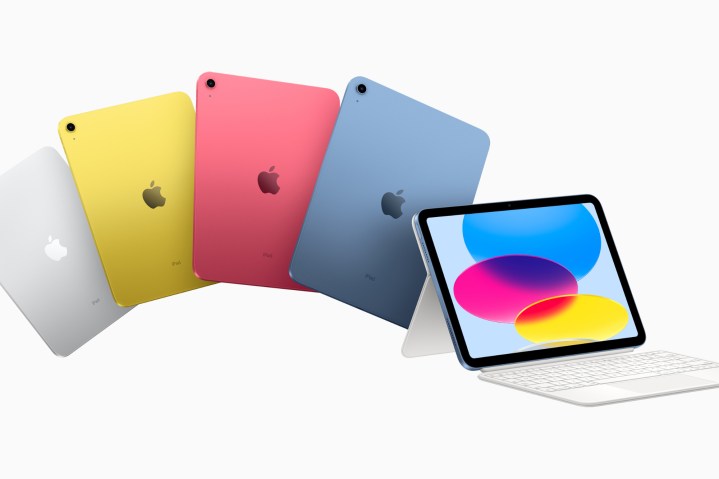
Lastly, the iPad (2022) and iPad Air (2022) are available in entirely different assortments of colors. Apple has gone with brighter and more “fun” blue, pink, and yellow finishes for the iPad, with silver as the plain model. The iPad Air comes in much more muted pink and blue options, plus purple, Starlight, and Space Gray.
Winner: iPad Air (2022)
iPad versus iPad Air performance
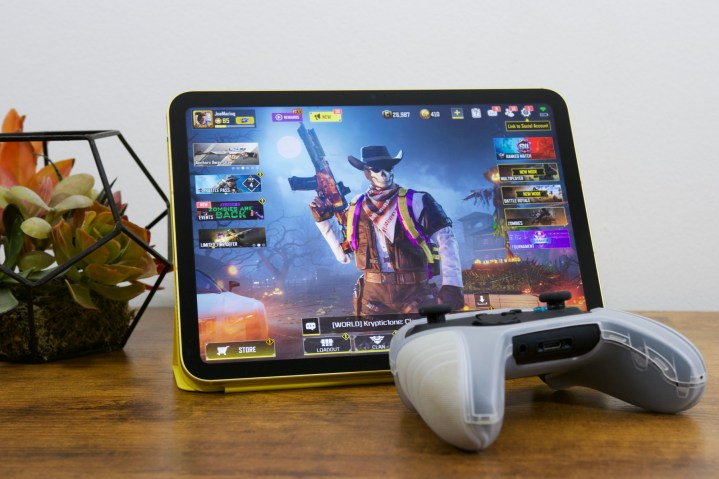
While Apple surprised us by adding its M1 chip to the iPad Air this year, the entry-level iPad offers no such bombshells. Instead, it predictably packs in the A14 Bionic, superseding the A13 Bionic found in its predecessor.
Of course, the A14 chip is no slouch; it was the same chip used in Apple’s entire 2020 iPhone 12 lineup, so it’s more than capable of handling nearly everything except the most demanding professional workflows. That easily includes day-to-day productivity tasks, web browsing, streaming video, gaming, photo editing, and even light-duty video editing.
Nevertheless, the M1 chip in Apple’s iPad Air puts the midrange tablet in an entirely different class. After all, this is the same chip used in Apple’s current 24-inch iMac and many MacBook Air and MacBook Pro laptops that are still in widespread use. While iPadOS 16 doesn’t offer the same breadth of options as macOS, there are still some M1-exclusive features like Stage Manager and external display support that iPad (2022) owners won’t be able to take advantage of.
Winner: iPad Air (2022)
iPad versus iPad Air battery life and charging
According to Apple’s published specs, the iPad (2022) and iPad Air (2022) should provide nearly identical battery life. Apple says that’s up to 10 hours of surfing the web on Wi-Fi or watching videos. That drops to nine hours of surfing over a 5G connection. That’s on par with last year’s iPad (2021).
However, the iPad (2022) gets an edge by adopting USB-C. Yes, Apple has finally ditched the Lightning connector on its tablets. While you won’t necessarily get faster charging, this should make it easier to charge your iPad without having to tote around a USB-C to Lightning cable just for that purpose.
Winner: Tie
iPad versus iPad Air cameras
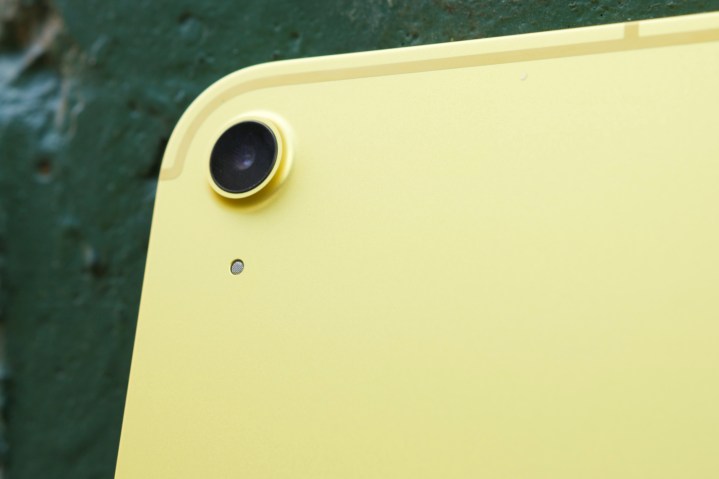
Although taking pictures with an iPad isn’t a priority for many folks, the iPad (2022) and iPad Air (2022) both offer the same 12-megapixel (MP) rear camera with an f/1.8 aperture, 5x digital zoom, and Smart HDR 3 support. While that doesn’t hold a candle to any of Apple’s recent iPhones, it gets the job done in a pinch, and it’s also more than adequate for tasks like scanning documents. It can also record 4K video at up to 60 frames per second (fps), with extended dynamic range and even support for recording slo-mo videos.
The front camera on the iPad (2022) also features identical specs to the one found on the iPad Air (2022), with a 12MP resolution, an f/2.4 aperture, and support for Center Stage and cinematic video stabilization. However, the iPad (2022) has a unique trick up its sleeve that we hope to see Apple embrace across the entire iPad lineup: a landscape front camera.
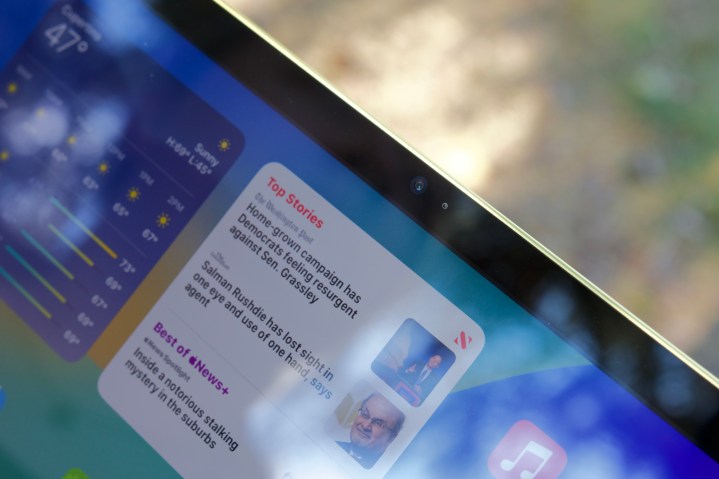
For the first time on an iPad, Apple has moved the front camera to the long edge, suitable for use when holding the iPad sideways in landscape orientation. This offers a more laptop-like user experience, and it’s a nice touch for folks who use their iPad with a keyboard on FaceTime and Zoom calls. It’s more natural to look into a camera above your screen rather than off to one side, and the angles make it appear to the other person that you’re actually looking at them rather than gazing off in a seemingly random direction.
Of course, the new camera position won’t appeal to those who prefer to use the iPad for video calls in portrait orientation. However, since most iPad stands and nearly all iPad keyboards are designed for landscape use, we think the new camera position makes a lot of sense, and it’s enough to give the new iPad (2022) an edge in this category.
Winner: iPad (2022)
iPad versus iPad Air software and updates
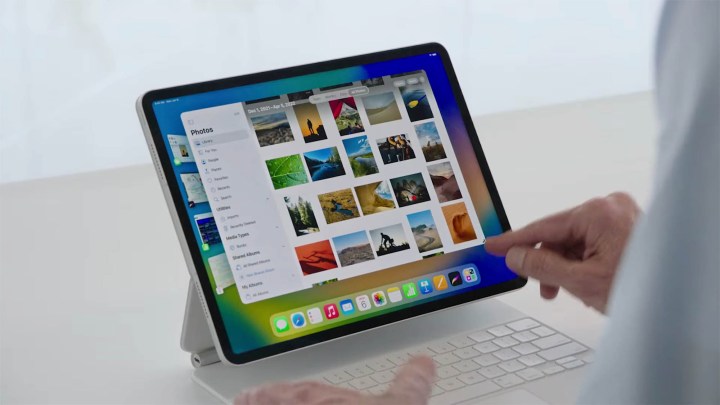
The iPad (2022) and iPad Air (2022) both run iPadOS 16, meaning they’ll offer a nearly-identical user experience. Thanks to its more powerful M1 chip, the iPad Air gets two unique iPadOS 16 features — Stage Manager and external display support — but both iPads should otherwise function identically from a software perspective.
Apple also releases its iPadOS updates for all models simultaneously, so both the iPad (2022) and iPad Air (2022) should remain in lockstep for at least the next few years. With the older A14 chip, it’s possible the iPad (2022) could be left behind before the M1-equipped iPad Air is by a future iPadOS release, but that’s still years away. To put this in perspective, iPadOS 16 still runs on the fifth-generation iPad released in March 2017, so it’s a safe bet that the iPad (2022) will someday be able to run iPadOS 21.
Winner: Tie
iPad versus iPad Air special features

Perhaps the biggest thing that separates the iPad (2022) and iPad Air (2022) is their support for Apple’s first-party accessories. When Apple brought the design of the iPad Pro to the iPad Air in 2020, the mid-tier tablet gained support for the same accessories as the flagship model. This included Apple’s Magic Keyboard and its second-generation Apple Pencil.
That continued in 2021 with the sixth-generation iPad Mini, at least in principle. While the smaller tablet obviously wasn’t going to work with Apple’s full-sized Magic Keyboard, it did offer the same Apple Pencil compatibility, right down to the magnetic charging dock on the side.
Sadly, that’s not the case with the iPad (2022). The new design is arguably a bit misleading, considering what happened with the iPad Air, but the bottom line is that you won’t be able to use any of the same accessories. The iPad (2022) only works with the first-generation Apple Pencil, which has to be charged rather awkwardly using a USB-C to Apple Pencil adapter — either directly from the iPad or an external USB-C charger. The lack of a magnetic charging dock also means there’s nowhere convenient to stash the Apple Pencil when you’re not using it.

Similarly, Apple inexplicably chose to keep the Smart Connector on the edge of the iPad (2022) rather than moving it to the back as it did with the iPad Pro and iPad Air. The 0.04 inches of extra thickness may have prevented the new iPad from fitting properly in the Magic Keyboard. Still, the side placement is yet another odd inconsistency for a design that otherwise looks so similar to the rest of the iPad lineup.
These issues don’t matter much if you’re not planning on using these accessories, but it’s tough to recommend the iPad (2022) to anybody considering the Apple Pencil; the first-generation stylus offers a significantly poorer user experience compared to the more magical second-generation model.
Winner: iPad Air (2022)
iPad versus iPad Air price and availability
The iPad (2022) is available in silver, blue, pink, or yellow in either 64GB or 256GB capacities starting at $449 for the Wi-Fi model or $599 for the Wi-Fi + Cellular (5G) version.
The iPad Air (2022) is available in Space Gray, Starlight, pink, purple, or blue in 64GB and 256GB capacities starting at $599 for the Wi-Fi version of $749 for the WiFi + Cellular model.
Overall winner: iPad Air (2022)

While the iPad (2022) is still the most affordable model in this year’s iPad lineup, it’s telling that Apple has kept last year’s iPad (2021) on the market to satisfy folks still looking for an even more wallet-friendly option. For years, Apple’s entry-level iPad has featured a starting price of $329, so this year’s jump to $449 for the new iPad (2022) is pretty significant.
The real challenge is that it closes the gap between the two product tiers in a way that makes the jump to the iPad Air much more appealing. At about half the price of the iPad Air, Apple’s basic iPad was an easy sell for folks looking for a tablet for casual personal or family use. Now, the iPad (2022) sits nearly in the middle of that gulf — and it doesn’t bridge it in the way you might think.
With the iPad (2021) still on the market and the iPad Air (2022) offering a tantalizing upgrade with its much better Apple Pencil support, laminated screen, and more powerful M1 chip, the iPad (2022) is a hard sell. Folks looking to spend as little as possible are better off staying with the 2021 model, while others should consider spending the extra money to jump to the much better iPad Air.



